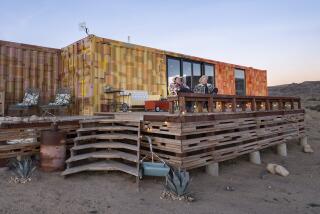Photographic Notes From a Desert Rat
Photographer Richard Misrach wasn’t exactly surprised when his latest series of pictures drew skepticism from friends and dealers in 1994. He realized the photographs were not the usual landscape images. There were no horizon lines, no trees, no clouds, just . . . skies: rich fields of color, blues, reds, grays. But Misrach was just as certain that these minimalist photographs were an important new layer to his 18-year examination of the Southwestern desert landscape. The pictures, he says, “may be difficult for people, but [the series] pushes what this work is all about to another level. I’m convinced it’s integral.”
The new series, called “Skies,” has since enjoyed broad acceptance from critics and collectors, who have come to see them much as Misrach does: as a logical extension of his iconoclastic redefinition of landscape photography.
On Saturday, an exhibition of “Skies” opens at the Jan Kesner Gallery in Los Angeles. At the same time, Misrach’s epic “Desert Cantos” project (which includes “Skies” and 17 other “cantos” or chapters) is now the subject of a major traveling retrospective curated by Houston’s Museum of Fine Art (work that is also collected in “Crimes and Splendors,” a catalog published by Bulfinch/Little Brown).
Though not documentary photography, Misrach’s work is often content-heavy, capturing quietly alarming landscapes, many of which reveal environmental devastation caused by the military and the endlessly quirky encroachment of civilization. His images have stretched from grim desert fires to bullet-ridden Playboy magazines found on the fringes of the Nevada Nuclear Test Site.
In 1992, Times art reviewer Susan Kandel wrote that the pictures “offer an exhaustive chronicle of the surprisingly varied landscape of the American desert--its space and scale, its highways and terrain, its prey and defilers.”
*
Now 47, the Los Angeles-born Misrach had shown no interest in the desert as a young man. Back in high school, his interests had revolved around surfing and skiing, and his knowledge of the desert came from passing through it as quickly as possible while en route to the slopes of Mammoth. “I hated the desert,” Misrach remembers, chatting while on vacation recently with his family in a rented Oxnard beach house. “It was ugly, it was barren, it was all the stereotypes. It wasn’t until I was well into my 20s that I discovered the desert for the first time.”
Though initially influenced by West Coast landscape masters Ansel Adams, Wynn Bullock and Minor White, Misrach lost interest in “just looking for the great view,” he says. “I became much more interested in the political aspect, social aspect and cultural aspect of landscape representation. It became much more complex.”
Relaxing barefoot on a couch with his surfboard and 8-by-10 view camera nearby, Misrach explains: “The whole ‘Desert Cantos’ project is really about layering different ideas and different approaches to landscape to bring out different kinds of meaning. The traditional view was sort of the starting point, and it’s broken down over the years.”
Misrach first began taking snapshots in high school in the mid-1960s. By the time he was involved in the antiwar movement while studying psychology at Berkeley, he was using a 35-millimeter camera to document campus rioting. But it wasn’t until he saw an exhibition by photographer Roger Minick on the Mississippi River Delta that Misrach understood the profound impact of the photographic image.
“The powerful nature of the realism of photography really hit me for the first time,” Misrach says of his first reaction to Minick’s work. For Misrach it was a revelation that photography “could be used as an art form. It transcended the snapshot. There was something else there.”
Soon he was working in the campus darkroom, earning a modest living as a glorified janitor while making his own prints. He had found comfort in the solitude of working alone in the field and in the darkroom. “Once I began making pictures, I just knew it was right for me,” says Misrach, who still lives in the Bay Area, in Emeryville. “It’s never happened again in my life before or since, anything like that. I had an instant love and passion for the process.”
In 1972, he began a two-year project photographing the street people of Telegraph Avenue, just blocks away from the Berkeley campus. He made 65 portraits in black and white, with the help of a grant from the National Endowment for the Arts, but he was finally uncomfortable with the published outcome of the project, not convinced that their hard lives should have become fodder for a coffee-table book.
“Did this really serve the people that I thought I was serving?” Misrach asks. “I had a social agenda, but was it doing that? I realized it made for a better art book than it did helping people.”
Armed with another NEA grant and a Guggenheim Fellowship, Misrach ventured into the desert for the first time, inspired by descriptions of the terrain by author Carlos Castenada. Those first pictures were also starkly black and white, with the aim of capturing “landscapes that had both a social agenda and an aesthetic art agenda.”
By the late ‘70s, he had turned to color and the 8-by-10 camera. “The desert’s colors are remarkable, such a phenomenal [part of the] experience of being in the desert,” he says, “that it seemed like something I really wanted to explore.”
His routine ever since has been to pack his camera, film and food into a van and then wander alone into the desert for two to three weeks at a time, producing about 1,500 8-by-10 negatives a year. While focused initially on the deserts of California and Nevada, Misrach’s work has led him as far as Texas and Utah (along with sojourns to the Middle East for a “prologue” to the “Cantos” series). Misrach now spends about four months traveling away from his wife, writer Myriam Weisang Misrach, and his 15-year-old son, Jake.
Among his discoveries in the desert was unexpectedly finding military activity: illegal bombing ranges, abandoned bases, military personnel carriers painted to look like school buses, riddled with bomb damage.
“That actually politicized me pretty quickly and made me realize that all these representational aspects all these years didn’t show what was actually going on in the landscape,” he says. “There was a breakdown between what people saw and what was going on.”
At the Bravo 20 bombing range in Nevada, where Misrach documented how the Navy had been dropping ordinance without congressional authorization for 40 years after World War II, the photographer was ordered to leave. He got around that through an obscure 1872 mining law, after buying a piece of the land and claiming he needed to survey it day and night.
*
Misrach’s work suffered a devastating blow in 1982, when a photo lab fire destroyed his first 3,000 “Desert Cantos” negatives. “It was probably one of a photographer’s worst fears, but the reality was that it just wasn’t that bad,” he says now. “You just go out and shoot again and move on. It cleaned the slate in a way. But there are still negatives that I lost that I wish I had.”
Undaunted, Misrach continued with the project. By the late 1980s, he began work on a “Canto” called “Clouds (Non-Equivalents),” photographs made in the desert of natural and man-made clouds: At least one image of a dark cloud has an industrial smokestack cropped just outside the frame.
Misrach has since begun work on additional “Cantos”--photographs he’s not yet comfortable discussing--but, as with other segments, “Skies” is far from complete for him. He sees the series as the apotheosis of the entire project so far.
“You think you’re just looking at beautiful light, color and form. There seems to be no political content. There’s nothing about the cultural landscape. And yet it’s so loaded.”
He heightens that paradox in “Skies” through the labeling of the exact location, date and minute the pictures are made. “Photography is about the instantaneous moment, and yet skies have always been associated with eternity, the ethereal and timelessness.”
Not surprisingly, the photographer has no plans yet to move on to subjects outside his beloved desert terrain.
“My work keeps evolving, and I never really know where it’s going to go. The desert leads me, rather than the other way around.”
*
“SKIES,” Jan Kesner Gallery, 164 N. La Brea Ave. Dates: Opens Saturday. Regular hours: Tuesdays to Saturdays, 11 a.m. to 5 p.m. Ends Oct. 12. Phone: (213) 938-6834.
More to Read
The biggest entertainment stories
Get our big stories about Hollywood, film, television, music, arts, culture and more right in your inbox as soon as they publish.
You may occasionally receive promotional content from the Los Angeles Times.











